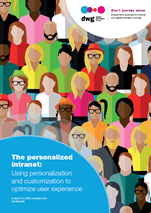Six success factors for a personalized intranet

Good personalization, like good design, should be so well-embedded that you don’t notice it.
Our personal digital lives wrap around us in a cocoon of personalized and customized content and services. It may not always seem immediately obvious, but our search results, our social media streams, our online shopping experience, the adverts we see, the content in the apps we use – so many of them are polished and finessed to present content and information directly targeted at us. To you. To me. And our interests, our habits, our behaviours, our needs.
The personalization and customization industry is developing and maturing to such an extent that we now have services like Siri, or Cortana, that try to predict our needs based on context, and bring what we need to us before we’ve even asked for it. They are becoming our own digital personal assistants.
However, good personalization, like good design, requires a lot of hard work to seem effortless.
Digital workplace personalization isn’t quite there yet. In fact, for a whole myriad of reasons, the personalization Holy Grail is one that intranet and digital workplace practitioners seem to find difficult to grasp.
Recent DWG research, however, has identified six key success factors that can help you develop an approach that is more likely to create a personalized platform that supports and brings value to users.
So, what are personalization and customization?
This is a question that can trigger multiple answers, as a cursory Google search will reveal. For DWG, we define these two terms as follows:
Personalization: The automated targeting of content to specific audience segments, based on their profile data.
Customization: The ability for users to set their own preferences about what they wish to see. This could be setting the news they are interested in based on predefined parameters, such as taxonomy, or the ability to add, remove and place specific web parts (or widgets) to change the configuration of the page they’re looking at.
Six success factors for a personalized intranet

If you’re looking either to improve your personalization approach, or to develop one for the first time, these are the six key areas you need to be getting right – as a minimum.
| Success factor | What it is | Why it’s important |
| Audience needs | Understanding the needs of your audience is a practice taken straight out of the user-centred design handbook. | Not having research into what your audience actually needs from their content means that, even if you have established basic audience segments, the content these segments receive will likely be irrelevant to them. |
| Audience segmentation | Audience segmentation refers to the way in which you divide up the large population of people who will be using your intranet. It allows you to group people together into distinct categories based on their shared characteristics. | This is an essential step when developing a personalization approach; without it, you have no language or framework for deciding what content needs to go to whom. |
| User profile data | User profile data refers to the actual data available about users, which helps identify who they are. Fields that are normally available as a minimum are their name, location, job role and business function. | Without user profile data, it will be impossible to provide a personalized or customized experience to your audience as the platform will have no way of distinguishing between different users. |
| Platform functionality | While it’s often said that technology can’t be relied upon as the only success factor for projects, we shouldn’t dismiss the importance of getting the technology right. | It’s important to map your audience needs – and your own requirements – back to the technology’s functionality, otherwise you may be at a loss as to how to practically implement the solutions needed. |
| Content strategy | Having a content strategy is much wider than what we are focusing on here, but for our purposes it refers to having a purposeful discussion and agreement on what content needs to be targeted to which audience segment, based on your understanding of their needs. | This is important because, without a strategy, even if you know your audience needs and segments, the actual content you create won’t be mapped back to the best audience. |
| Managed metadata | Having managed metadata refers to the ability to define information about your content, such as what topics it relates to, the type of content it is, and so on. | This is key to being able to define for whom a piece of content is intended, and is essential for anyone implementing personalization or customization on their intranet. For example, if you want users to be able to subscribe or unsubscribe to particular news topics, you need to be able to categorize your news into those topics, so that they appear in the right place for the right person. |
Where to start
While our research revealed additional areas that can also contribute to an effective personalization approach, these six should be seen as your “must haves”. So where should you start?
- Take stock of your current state for each of these six factors
- Note down the gaps between your current state and where you would need to be in order to implement an effective personalization approach (either an improved solution or a new one).
- Work through how much work it would take to get to your desired state, including budget, time and collaboration with other departments.
- Prioritize which areas you should focus on first, dependent on factors such as quick wins, piggybacking other projects and your organization’s current focus.
- Create a roadmap that sets out when you’d like to focus on each of these areas.
- Have initial sounding-out conversations with relevant stakeholders, to find out what can practically be achieved.
Cost
This report is included in DWG’s annual membership. If you are already a member, download the full report on the DWG extranet.
Related Research and Resources
Arrange a call to learn more
Categorised in: Content management, Research reports, Search & findability, Strategy & governance, Usability & design


